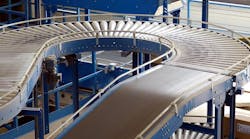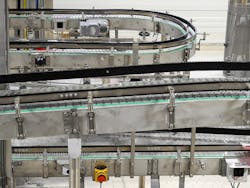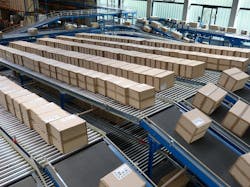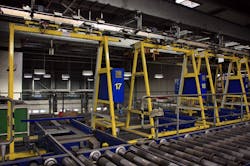Conveyors are commonly used devices on assembly lines across a wide range of industries. They are often used to transport material with minimal effort within a short distance. They are a critical element in today’s ever-evolving supply chains and manufacturing processes.
While conveyors might seem simple, their scale and application make it necessary to choose the right one. You may end up spending additional time and money if you don’t consider basic properties such as weight, speed, maintenance, washdown requirements, and more when selecting a conveyor. In this article, we will review conveyor types and the critical factors for selecting the right tool for the right job.
Conveyors come in different shapes and sizes depending on the end-application. Here are the most common types of conveyors:
Beam trolley systems. These are one of the earliest types of overhead conveyor systems. You can find these versatile conveyors anywhere, from home workshops to automobile assembly lines. Usually, you must attach a product to the overhead trolley by a hook.
Features and drawbacks:
- Easy to move products around curves.
- Easy to move heavy objects on assembly lines.
- Easy to install and ensure minimal downtime.
- Difficult to use on inclines or declines as loads move under their own weight, causing accidents.
Belt conveyors. They are the most commonly used powered conveyor systems. They comprise two or more pulleys with an endless belt which is the carrying medium. The belt, which is made from PVC or rubber, rotates about the pulleys to move the load.
Features and drawbacks:
- Relatively cost-effective.
- Suitable for batch type production process.
- Gentle product handling.
- Abrasive materials can damage the belt.
- May not be suitable for heavy loads.
Chain conveyors. These use a similar concept as belt conveyors. Instead of a belt, however, they use a chain mesh to move products. Chains can be made of different materials and may come in different sizes and shapes depending on the application.
Features and drawbacks:
- Suitable for heavy loads.
- Easy to install.
- Low maintenance.
- Higher energy consumption.
- Not suitable for fragile loads.
- Relatively limited or slow speed.
Inverted conveyors. Inverted conveyors come in power and free variants. They allow you to stop individual loads without holding the entire assembly line.
Features and drawbacks:
- Variable chain speeds.
- High-speed indexing.
- On-the-line storage.
- Higher adaptability.
- Higher energy costs.
- The chain dogs may need periodic replacement.
Live or motorized roller conveyors. These conveyors have rolling bars that usually push the loads in a forward motion. They can be powered or motorized or gravity-based systems.
Features and drawbacks:
- Easy product movement.
- Suitable for a variety of load sizes and weights.
- Easy to clean.
- Safe for handling fragile products.
- Expensive installation and maintenance.
- Requires skilled labor for repair.
- Longer downtime if they break down.
- Most models are unidirectional.
Overhead conveyor. Usually, overhead conveyors are used on assembly lines to move relatively heavy objects. They use a single rail with either an enclosed track or an I-Beam pulley system.
Features and drawbacks:
- Better floor-space utilization.
- Bi-directional product movement.
- Easy to move loads in bulk.
- Known for higher safety.
- Relatively expensive systems.
- Longer downtime if the system breaks down.
- Chain-based systems need continuous lubrication.
Over-under conveyors. Over-under conveyors are the best solution for limited floor spaces. They usually have two or more conveyor lines stacked on top of one another. They are available as gravity-feeding or motorized systems.
Features and drawbacks:
- Function as accumulating or indexing conveyor.
- Maximizes the use of floor space.
- Ability to handle heavy loads.
- High power consumption.
- May need manual loading and unloading of objects.
Slat conveyors. These conveyors have slats or plates made of steel, wood, or other materials. The slats are usually mounted on roller chains. They are neither interlocked nor do they overlap.
Features and drawbacks:
- Suitable for moving large, heavy objects such as crates and drums.
- Extended service life of the conveyor.
- High energy consumption.
- Expensive installation and maintenance.
However, having an extensive range of options makes it difficult to choose the right conveyor that suits your application. Taking the following factors into account should help.
Understand the Product Specifications
One of the first factors you will need to consider is the product specifications or your material handling requirements. You should take the following four product specifications into account every time you invest in a high-tech conveyor system.
Weight. The weight will determine various elements of your conveyor system, including the diameter of rollers, roller gauge requirements, type of material for roller bed, and the size of the motor, among others. If the products are heavy, you will need a sturdy conveyor structure with a powerful motor, especially if you are moving the products against gravity or horizontally.
Dimensions. Consider the length, width, and height of the products to determine if they will fit on the conveyor of your choice. Larger products often need conveyors with wider belts, higher guide rail specifications, and bigger roller centers.
Type. Products are made of different materials such as metal, wood, plastic, or even glass. If you are moving glass bottles, you will need a roller bed conveyor at a slow speed. On the other hand, you can use a chain-driven roller conveyor to move wooden boxes or pallets. However, a simple belt or roller conveyor is enough to move bags of chips or any other dry snack.
Production or moving rate. How many parts per minute do you need to move? Larger product dimensions coupled with a higher production rate will require a conveyor with moderate speed and larger belt width.
Consider the Maintenance Costs
Keeping conveyor systems up and running is a challenging task as they have several different mechanical parts requiring preventive maintenance. The mechanical components, like most machines, won't get better with age.
You don’t want to end up investing in a system that leads to frequent breakdowns and reduces your productivity. Make sure to enquire about the operational record of a conveyor system you want to buy.
All mechanical parts, no matter how high their quality is, eventually wear out over time. So, make sure these critical spare parts are readily available. Also, try to find out how much mechanical skill is required, should you have to repair the system or replace a part.
It is better if you can take care of it with the help of an in-house mechanic. If external support is needed, find out how quickly it can help you resolve the issue. Finally, get an estimate of the preventive maintenance costs if possible. It will give you an idea of whether or not you can afford this system.
Think about Clean-up Requirements
Some work environments, such as food processing and even electronics manufacturing, will require a daily cleanup of the conveyor systems. While in some cases wipe-down levels of cleaning with water is enough, others may need a thorough chemical wash to avoid contamination.
Most production environments allow bolted conveyor setups. However, washdown specifications may not allow systems mounted on standoffs. You may need to lift some parts of the conveyor system using wire rope slings or other lifting equipment to clean them up thoroughly.
Check if you need dismantling before the cleanups, as it will be a time-consuming process. You will also need to have a trained workforce and financial resources to meet these washdown requirements.
Your choice of the conveyor system will depend on your cleaning requirements. For example, the USDA requires you to use conveyors made from stainless steel or an equally corrosion-resistant material for handling raw meat or cheese, as they are easier to clean.
On the other hand, if you are using harsh chemicals such as chlorine for cleaning, using a plastic chain conveyor is not an option. Chlorine often damages acetal plastic used in these conveyors.
Parting Words
From manufacturing to warehousing, conveyors are an indispensable element of material handling systems. However, you need to select the right type of conveyor to increase your productivity and reduce downtime. You need to gather as much information as possible before making a decision. Hopefully, keeping these three factors in mind should prove helpful in choosing a conveyor that suits your material handling requirements. Which element do you think is the most crucial one? Tell us in the comments section.
Vernon Glick is an experienced and passionate writer and blogger by profession, with years of experience in delivering unique and high-quality content. He keeps exploring the web and loves to do in-depth research when things come to writing. He loves to hang out with family and friends and indulges in nature photography. He can be contacted at [email protected].




